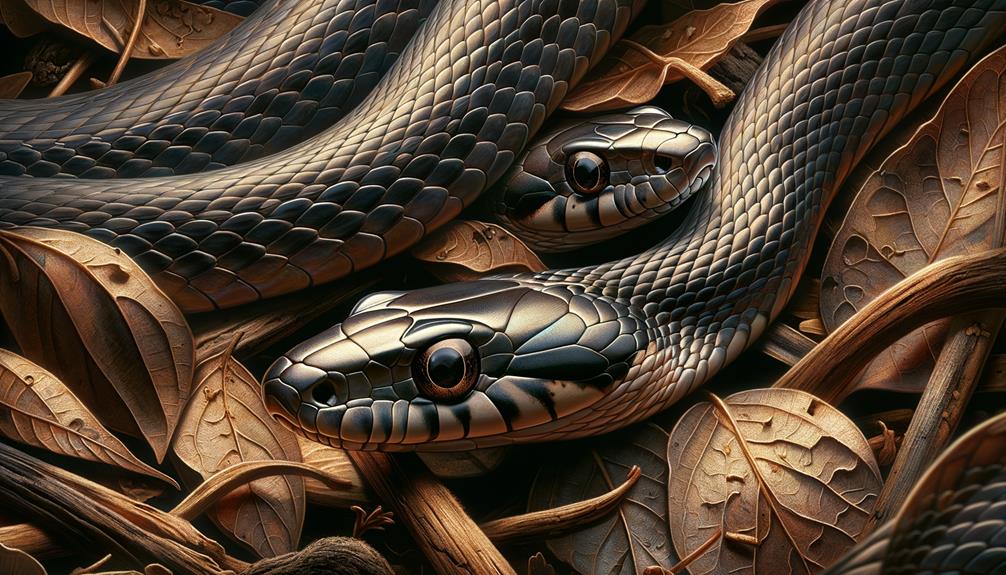I've always been fascinated by smooth snakes due to their secretive nature and specialized habitats. These elusive reptiles thrive in sandy heathlands across regions like Dorset and Devon. Efforts to reintroduce them and protect their habitats are crucial for their survival. Despite facing threats from predators and habitat loss, these snakes demonstrate remarkable resilience. To identify them, you need a keen eye – look for their slender bodies and round pupils. Ongoing monitoring efforts reveal promising population trends, signaling a successful range expansion. Want to learn more about these conservation achievements and how you can contribute to them?
Key Takeaways
Smooth snakes are notoriously difficult to spot due to their specialized habitats and secretive nature. Their slender bodies and subtle dark patterns allow them to blend seamlessly into their natural surroundings.
Conservation efforts focus on reintroduction programs and habitat monitoring in regions like Dorset, Hampshire, Surrey, West Sussex, and Devon. Preserving habitats, monitoring populations, and breeding programs are crucial for ensuring population growth.
Long-term monitoring and effective habitat management are vital for understanding population trends and achieving successful conservation.
Reintroduction Efforts
Reintroduction efforts for the smooth snake, Britain's rarest serpent, have begun in Devon following a 50-year absence. Led by the dedicated team at the Amphibian and Reptile Conservation (ARC) charity, this initiative marks a crucial step forward for the species' future.
The project involves carefully collecting smooth snakes from Dorset, where they still thrive, and releasing them into restored heathland habitats in east Devon. These habitats are vital for the snake's survival, providing the necessary shelter and prey. The ARC charity aims to not only re-establish the smooth snake population in Devon but also to promote range expansion, thus bolstering the population across southern England.
Habitat and Range

Smooth snakes have a highly specialized habitat range, which underscores their rarity and the importance of targeted conservation efforts. As a reptile native to the UK, they are found almost exclusively in sandy heathlands, which provide the ideal conditions for their survival and reproduction. These snakes thrive in heathland and moorland areas, where they can find ample prey like sand lizards, slow-worms, insects, and nestlings. This specialized habitat makes their distribution very limited, further highlighting their elusive nature.
Due to their rarity, smooth snakes are protected under various UK and European laws. Conservation efforts have led to the reintroduction of this elusive reptile in regions like West Sussex and Devon, where suitable habitats have been carefully managed. Monitoring these reintroduced populations is crucial to ensuring their long-term survival in these areas.
Predators, including birds and mammals, pose significant threats to smooth snakes, making their choice of habitat even more important. By safeguarding their preferred heathland environments, we can help maintain the delicate balance that allows these fascinating reptiles to thrive. Their presence is a testament to the health and biodiversity of these precious ecosystems.
Identification Tips

Recognizing smooth snakes in their natural habitat can be a challenge, but by paying attention to specific characteristics, you can distinguish them from their more common relatives. In my experience, the smooth snake's slender body and round pupil are key identification markers. Unlike adders, smooth snakes have a less distinct dark pattern on their backs, typically appearing grey or dark brown.
You'll often find them in specific UK regions like Dorset, Hampshire, Surrey, West Sussex, and Devon. They thrive in sandy heathland, which makes them even more elusive. If you're in areas with reintroduced populations, such as West Sussex and Devon, your chances of spotting one improve.
These snakes are fascinating predators, feeding on sand lizards, slow-worms, insects, and nestlings. Their behavior and diet contribute to their stealth, making them harder to spot. To avoid predators like birds and mammals, they often remain well-camouflaged.
Understanding these subtle differences is vital for accurate identification. Next time you're exploring sandy heathlands in the specified UK regions, keep an eye out for these remarkable, elusive natives. With patience and attention to detail, you might just spot a smooth snake.
Conservation Challenges

When I look at the challenges facing smooth snakes, I see a complex interplay of preserving habitats and human activities that threaten their survival. To ensure their survival, we must focus on restoring their natural habitats and monitoring their populations. Additionally, breeding programs and public awareness campaigns are crucial for raising awareness and fostering collaboration between conservation organizations and research institutions.
Habitat Preservation Efforts
Despite our best conservation efforts, the historical loss of natural habitats poses significant challenges to preserving the smooth snake's environment. These elusive reptiles rely on specific heathland ecosystems, which have drastically decreased over the years. Preserving their habitats is crucial for the smooth snake's survival, and various conservation initiatives focus on this goal.
One key strategy is restoring heathlands. By rejuvenating these unique landscapes, we can create the necessary conditions for smooth snake populations to thrive. Reintroduction projects in regions like Devon have shown promise, aiming to boost numbers and facilitate range expansion. These projects are meticulously planned to ensure that snakes are reintroduced into suitable, well-managed habitats.
Collaboration is vital to our efforts. By working closely with organizations like the Amphibian and Reptile Conservation (ARC) charity, we can pool resources and expertise to maximize the impact of our habitat preservation strategies. The ARC charity plays a critical role in coordinating efforts and advocating for the smooth snake's conservation.
While historical habitat loss remains a significant obstacle, our combined efforts in heathland restoration and targeted reintroduction projects are steps in the right direction to secure the future of smooth snakes in the UK.
Threats From Human Activity
Human activities pose a significant threat to the survival of smooth snakes. Habitat destruction, fragmentation, and pollution are major concerns. Urbanization and agriculture encroach on their habitats, limiting their range and breeding sites. Road development and traffic mortality also have a devastating impact on smooth snake populations, often leading to fatal encounters with vehicles.
When habitats are divided, smooth snakes struggle to move between them, making it difficult for populations to interbreed and maintain genetic health. Pollution further exacerbates these threats by contaminating the environments where smooth snakes live. Chemical runoff from agriculture and urban areas can degrade their habitats, making them less hospitable.
Human activities affect smooth snakes in several ways:
Habitat destruction from urbanization and agriculture reduces the available living space for smooth snakes. Road development divides habitats, isolating populations. Snakes crossing roads often get hit by vehicles, leading to traffic mortality. Pollution from various sources contaminates their habitats, making them less suitable for smooth snakes.
To mitigate these human-induced threats, conservation efforts focus on creating safe havens where smooth snakes can thrive, ensuring their continued survival amid growing human pressures.
Breeding Program Initiatives
Overcoming the challenges of reintroducing smooth snakes to Devon's heathland after a 50-year absence requires a targeted approach. Our breeding program initiatives tackle these conservation challenges head-on. The initial phase involves collecting smooth snakes from Dorset, where they still thrive, and releasing them into a carefully monitored nature reserve in east Devon.
| Conservation Challenge | Approach |
|---|---|
| Habitat Restoration | Re-establishing native vegetation and removing invasive species |
| Monitoring Population | Using radio telemetry to track released snakes |
| Community Engagement | Educating locals about the importance of smooth snakes |
Restoring habitats is crucial for supporting the smooth snake's return. This involves meticulous efforts to re-establish native vegetation and remove invasive species that could threaten their survival. Given the secretive and timid nature of smooth snakes, sightings are less frequent, making it important to employ technologies like radio telemetry to monitor their movements and behaviors.
The Amphibian and Reptile Conservation (ARC) charity spearheads these initiatives, fostering a sense of community around the reintroduction. By educating locals about the importance of this native species, we not only conserve them but also enrich the biodiversity of Devon's heathland. Through these targeted efforts, we aim to see a thriving population of smooth snakes once more in east Devon.
Monitoring Success
I've been fascinated by the meticulous process of tracking population trends of smooth snakes. Our team has recorded over 18,000 entries, which have revealed 1,600 smooth snakes and 1,500 adders, and pinpointed 23 new locations in South England. Despite these successes, we still face ongoing challenges with habitat monitoring techniques and data collection accuracy, which are crucial components of effective conservation efforts.
Tracking Population Trends
Tracking Population Trends
To better understand the smooth snakes in Devon's heathlands, we collect data on sightings, habitat preferences, and breeding success. This monitoring helps us grasp how these snakes fare in their environment. By observing where they're spotted, what habitats they prefer, and how often they breed, we can gauge the importance of their populations.
Our monitoring focuses on several key indicators:
- Sightings: If we see more snakes, it's likely their population is growing.
- Habitat Preferences: Identifying preferred habitats helps us manage those areas effectively.
- Breeding Success: More breeding pairs indicate a thriving population.
- Range Expansion: We observe new areas colonized by smooth snakes.
These data points drive our conservation strategies and habitat management plans. Long-term monitoring is vital; it allows us to track changes over time and adjust our efforts accordingly. For instance, if sightings increase, it might suggest successful conservation efforts. However, if breeding success declines, it could indicate issues needing immediate attention.
In essence, by meticulously tracking these trends, we're not just ensuring the survival of the smooth snake but actively contributing to the preservation of Devon's rich heathland ecosystem. This detailed, ongoing effort is critical for effective conservation.
Habitat Monitoring Techniques
Diverse habitat monitoring techniques have greatly advanced our understanding of smooth snake populations and their ecological needs. Through the ARC Survey Hub, we conducted extensive heathland reptile surveys in Devon, amassing over 18,000 records, including sightings of 1,600 smooth snakes and 1,500 adders. Notably, our efforts identified smooth snakes in 23 new locations across South England, highlighting the critical role of systematic monitoring.
Our habitat management strategies have been equally successful. We organized 66 habitat management task events focused on restoring degraded heathland areas, providing essential environments for reptiles. This hands-on restoration work supports a thriving ecosystem that benefits both smooth snakes and adders.
Educational outreach programs have also played a vital role. Nearly 4,000 children received lessons about reptile species, sparking curiosity and fostering a deeper connection with their natural surroundings. These lessons are not just about education; they're about cultivating future environmental stewards.
Together, these habitat monitoring techniques, combined with active habitat management and robust educational outreach, have laid the groundwork for a sustainable future for smooth snakes and their fellow heathland inhabitants in Devon and beyond.
Data Collection Challenges
While our habitat monitoring techniques and management strategies have proven effective, the secretive nature of smooth snakes presents significant challenges in data collection. These elusive reptiles are masters of camouflage, making it difficult to track their population and habitat suitability accurately. To overcome these obstacles, we employ specialized techniques and equipment tailored to the smooth snakes' unique behaviors.
We use radio telemetry to track individual snakes by attaching small radio transmitters to them, gathering valuable data about their range and habitat use. Artificial refuges, such as cover boards, are strategically placed within their habitat to help us observe and count these snakes without disturbing them. Visual encounter surveys involve systematic searches in potential habitats to locate and document snake populations, although they require significant effort and expertise. By engaging local communities in conservation efforts, we can increase the number of observers and foster a sense of responsibility.
Collaboration between researchers, conservationists, and the public is crucial. These joint efforts help us assess population trends and adapt our strategies to protect these fascinating, yet elusive, natives. Accurate monitoring data is vital for our ongoing conservation efforts, guiding our actions to safeguard the smooth snakes' survival.
How You Can Help

By joining the ARC membership for as little as £3 a month, you'll be directly supporting vital conservation efforts to protect and expand the population of Britain's rarest snake, the smooth snake. Your contribution to the Amphibian and Reptile Conservation (ARC) will back necessary projects focused on range expansion and reintroduction efforts for smooth snakes.
Historical records show that smooth snakes were once found in Devon, dating back to the 1950s. With your help, we can bring them back to their native habitats. Our reintroduction efforts involve collecting smooth snakes from Dorset and releasing them on heathland nature reserves in east Devon. This is crucial, as smooth snakes are rarely spotted due to their secretive and timid nature. By expanding their range, we aim to re-establish a stable population across the UK. Your support through ARC membership can make a real difference in these initiatives, giving these fascinating creatures a better chance of survival.
Together, we can preserve and enhance the habitats that smooth snakes rely on, allowing them to thrive once again. Let's take action now and make a positive impact on our native wildlife.
Frequently Asked Questions
What Do Smooth Snakes Primarily Eat?
I've always been curious about the diet of smooth snakes. They mainly feed on reptiles, such as lizards, and small mammals. On occasion, they'll eat amphibians. This diet allows them to thrive in their natural habitats.
How Long Do Smooth Snakes Typically Live in the Wild?
Smooth snakes can live up to 20 years in their natural habitats, thriving in undisturbed heathlands and woodlands where they can evade predators and avoid human interference, showcasing their remarkable adaptability and resilience.
Are Smooth Snakes Venomous or Harmful to Humans?
Smooth snakes are harmless to humans and don't produce venom. I find them fascinating because of their non-aggressive nature and secretive behavior. They play a crucial role in the ecosystem by controlling small rodent populations and maintaining natural balance.
What Are the Main Predators of Smooth Snakes?
Around 70% of smooth snake predations are attributed to birds of prey. It's intriguing that these secretive snakes face threats from raptors like kestrels and buzzards, which hunt with remarkable precision.
Do Smooth Snakes Exhibit Any Unique Breeding Behaviors?
I find smooth snakes fascinating because of their unique breeding behaviors. They give birth to live young, a rare trait among snakes, which increases the chances of their offspring's survival. This unusual reproductive strategy ensures that their young are born into a safe and nurturing environment, giving them a better start in life.



